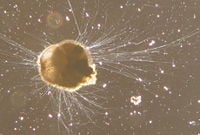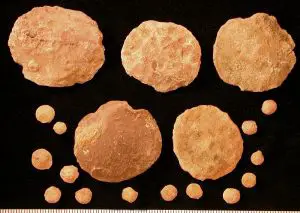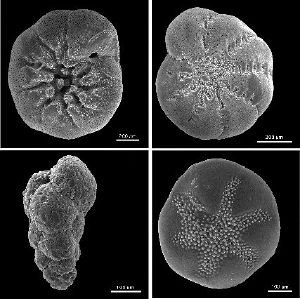Foraminifera
| Foraminifera
| ||||||||||||
|---|---|---|---|---|---|---|---|---|---|---|---|---|
 Live Ammonia tepida (Rotaliida)
| ||||||||||||
| Scientific classification | ||||||||||||
|
Foraminifera, abbreviated as forams, are single-celled amoeboid protists comprising the order Foraminiferida (or Foraminifera of supergroup of Rhizaria), characterized by reticulating pseudopods and typically a shell. As members of the Granuloreticulosea, they tend to posses granuloreticulose pseudopodia, which are temporary, threadlike, cytoplasmic projections that branch and merge to form a dynamic net and that often include grains or tiny particles (Olney 2002; Hemleben et al. 1989). The shells or tests can have either one or multiple chambers, although the simple forms are hollow spheres or open tubes (Wetmore 1995; Kennett and Srinivasan 1983). The name foraminifera ("hole bearers") comes from the connecting hole (foramen) through the wall (septa) between each chamber (Olney 2002). Some tests are quite elaborate in structure.
Foraminifera may be planktonic or benthic and range in size from about 100 micrometers to almost 20 centimeters (7,9 inches) (Wetmore 1995).
Description
Generally, extant foraminifera are known as organisms that have a shell (test) and live in marine environments. However, some are naked (lack a shell) and some are found in brackish conditions (Sen Gupta 1983), freshwater environments (Reticulomyxa filosa, Toxisarcon synsuicidica) and even in terrestrial environments in damp soil (Edaphoallogromia australica) (Schweizer 2006; Schweizer et al. 2008).
Forams are characterized by pseudopodia called granuloreticulopodia, which form a network and contain granules. For such reasons, they traditionally have been placed in the class Granuloreticulosea, as comprising the order Foraminiferida (ITIS 2003; Olney 2002). As members of Granuloreticulosea, they were grouped with the lobose and filose amoebae are part of the superclass Rhizopoda, subphylum Sacrodina, and phylum Protozoa. However, molecular data has challenged the monophyly of Rhizopoda nd newer classifications include ones that place the forams in the subgroup Rhizaria, one of the major eukaryote groups, and list them as comprising the Rotaliida or Foraminifera phylum (Schweizer 2006; Schweizer et al. 2008).
Rotaliida (Foraminifera)
can survive in brackish conditions (Sen Gupta 1983)
There are about 4,000 described living species of foraminifera (Olney 2002). Most are less than 1 millimeter in size, although the largest specimen is almost 20 centimeters in length. Modern forams are primarily marine, although they can survive in brackish conditions (Sen Gupta 1983). A few species survive in fresh water and one even lives in damp rainforest soil (Schweizer 2006; Schweizer et al. 2008).
Originally studied by paleontologists, foraminifera were considered organisms living in marine environments and with a shell (test). However, the finding of forms without a shell ( freshwater**
terrestrial
They are very common in the meiobenthos, and about 40 morphospecies are planktonic.[1] This count may however represent only a fraction of actual diversity, since many genetically discrepant species may be morphologically indistinguishable.[2] The cell is divided into granular endoplasm and transparent ectoplasm. The pseudopodial net may emerge through a single opening or many perforations in the test, and characteristically has small granules streaming in both directions.[3]
The pseudopods are used for locomotion, anchoring, and in capturing food, which consists of small organisms such as diatoms or bacteria.[1] A number of forms have unicellular algae as endosymbionts, from diverse lineages such as the green algae, red algae, golden algae, diatoms, and dinoflagellates.[1] Some forams are kleptoplastic, retaining chloroplasts from ingested algae to conduct photosynthesis.[4]
The foraminiferal life-cycle involves an alternation between haploid and diploid generations, although they are mostly similar in form. The haploid or gamont initially has a single nucleus, and divides to produce numerous gametes, which typically have two flagella. The diploid or schizont is multinucleate, and after meiosis fragments to produce new gamonts. Multiple rounds of asexual reproduction between sexual generations is not uncommon in benthic forms.[3] Foramanifera typically live for about a month.[5]
lthough as yet unsupported by morphological correlates, molecular data strongly suggest that Foraminifera are closely related to the Cercozoa and Radiolaria, both of which also include amoeboids with complex shells; these three groups make up the Rhizaria.[6] However, the exact relationships of the forams to the other groups and to one another are still not entirely clear.
Tests

The form and composition of the test is the primary means by which forams are identified and classified.[citation needed] Most have calcareous tests, composed of calcium carbonate.[3] In other forams the test may be composed of organic material, made from small pieces of sediment cemented together (agglutinated), and in one genus of silica. Openings in the test, including those that allow cytoplasm to flow between chambers, are called apertures.
Tests are known as fossils as far back as the Cambrian period,[7] and many marine sediments are composed primarily of them. For instance, the limestone that makes up the pyramids of Egypt is composed almost entirely of nummulitic benthic foraminifera.[8] Production estimates indicate that reef foraminifera annually generate approximately 43 million tons of calcium carbonate and thus play an essential role in the production of reef carbonates.[9]
Genetic studies have identified the naked amoeba "Reticulomyxa" and the peculiar xenophyophores as foraminiferans without tests.[citation needed] A few other amoeboids produce reticulose pseudopods, and were formerly classified with the forams as the Granuloreticulosa, but this is no longer considered a natural group, and most are now placed among the Cercozoa.[10]
Evolutionary significance
Dying planktonic foraminifera continuously rain down on the sea floor in vast numbers, their mineralized tests preserved as fossils in the accumulating sediment. Beginning in the 1960s, and largely under the auspices of the Deep Sea Drilling, Ocean Drilling, and International Ocean Drilling Programmes, as well as for the purposes of oil exploration, advanced deep-sea drilling techniques have been bringing up sediment cores bearing foraminifera fossils by the millions. The effectively unlimited supply of these fossil tests and the relatively high-precision age-control models available for cores has produced an exceptionally high-quality planktonic foraminifera fossil record dating back to the mid-Jurassic, and presents an unparalleled record for scientists testing and documenting the evolutionary process. The exceptional quality of the fossil record has allowed an impressively detailed picture of species inter-relationships to be developed on the basis of fossils, in many cases subsequently validated independently through molecular genetic studies on extant specimens.
Uses of forams
Because of their diversity, abundance, and complex morphology, fossil foraminiferal assemblages are useful for biostratigraphy, and can accurately give relative dates to rocks. The oil industry relies heavily on microfossils such as forams to find potential oil deposits.[11]
Calcareous fossil foraminifera are formed from elements found in the ancient seas they lived in. Thus they are very useful in paleoclimatology and paleoceanography. They can be used to reconstruct past climate by examining the stable isotope ratios of oxygen, and the history of the carbon cycle and oceanic productivity by examining the stable isotope ratios of carbon;[12] see δ18O and δ13C. Geographic patterns seen in the fossil records of planktonic forams are also used to reconstruct ancient ocean currents.[citation needed] Because certain types of foraminifera are found only in certain environments, they can be used to figure out the kind of environment under which ancient marine sediments were deposited.[citation needed]
For the same reasons they make useful biostratigraphic markers, living foraminiferal assemblages have been used as bioindicators in coastal environments, including indicators of coral reef health.[citation needed] Because calcium carbonate is susceptible to dissolution in acidic conditions, foraminifera may be particularly affected by changing climate and ocean acidification.[citation needed]
Foraminifera can also be utilised in archaeology in the provenancing of some stone raw material types. Some stone types, such as chert, are commonly found to contain fossilised foraminifera. The types and concentrations of these fossils within a sample of stone can be used to match that sample to a source known to contain the same 'fossil signature'.
ReferencesISBN links support NWE through referral fees
- ↑ 1.0 1.1 1.2 Cite error: Invalid
<ref>tag; no text was provided for refs namedHemleben - ↑ Kucera, M. and Darling, K.F. (2002). Genetic diversity among modern planktonic foraminifer species: its effect on paleoceanographic reconstructions. Philosophical Transactions of the Royal Society of London A360 (4): 695–718.
- ↑ 3.0 3.1 3.2 Cite error: Invalid
<ref>tag; no text was provided for refs namedSen Gupta - ↑ Bernhard, J. M. and Bowser, S.M. (1999). Benthic foraminifera of dysoxic sediments: chloroplast sequestration and functional morphology. Earth Science Reviews 46: 149–165.
- ↑ Crowley, T.J. and Zachos, J.C. (2000). Comparison of zonal temperature profiles for past warm time periods. Warm Climates in Earth History: 50–76.
- ↑ Cavalier-Smith, T. (2003). Protist phylogeny and the high-level classification of Protozoa. European Journal of Protistology 34 (4): 338–348.
- ↑ Sea creatures had a thing for bling - life - 08 May 2008 - New Scientist
- ↑ Foraminifera: History of Study, University College London, retrieved 20 September 2007
- ↑ Langer, M. R. and Silk, M. T. B., Lipps, J. H. (1997). Global ocean carbonate and carbon dioxide production: The role of reef foraminifera. Journal of Foraminiferal Research 27 (4): 271–277.
- ↑ Adl, S. M. and Simpson, A. G. B., Farmer, M. A., Anderson, R. A., Anderson, O. R., Barta, J. A., Bowser, S. M., Brugerolle, G., Fensome, R. A., Fredericq, S., James, T. Y., Karpov, S., Kugrens, P., Krug, J., Lane, C. E., Lewis, L. A., Lodge, J., Lynn, D. H., Mann, D. G., McCourt, R. M., Mendoza, L., Moestrup, O., Mozley-Standridge, S. E., Nerad, T. A., Shearer, C. A., Smirnov, A. E., Speigel, F. W., Taylor, M. F. J. R. (2005). The new higher level classification of Eukaryotes with emphasis on the taxonomy of Protists. Journal of Eukaryotic Microbiology 52 (5): 399–451.
- ↑ Boardman, R.S. (1987). Fossil Invertebrates. Blackwell, 714.
- ↑ Zachos, J.C. and Pagani, M., Sloan, L., Thomas, E., and Billups, K. (2001). Trends, Rhythms, and Aberrations in Global Climate, 65 Ma to Present. Science 292: 686–693.
- Olney, M. 2002. Foraminifera Microfossil Image Recovery and Circulation for Learning and Education (MIRACLE), University College London (UCL), Micropalaeontology Unit. Retrieved August 22, 2008.
- Integrated Taxonomic Information System (ITIS). 2003. Foraminiferida ITIS Taxonomic Serial No.: 44030. Retrieved August 22, 2008.
.[3]
Karen L. Wetmore 1995 http://www.ucmp.berkeley.edu/foram/foramintro.html Introduction to the Foraminifera University of California Museum of Paleontology
Evolution and molecular phylogeny of Cibicides and Uvigerina (Rotaliida, Foraminifera)
Evolution and molecular phylogeny of Cibicides and Uvigerina (Rotaliida, Foraminifera) / Magali Schweizer - 2006 Geologica ultraiectina ISBN 905744125X
Schweizer, Magali, Jan Pawlowski, Tanja J Kouwenhoven, Jackie Guiard, and Bert van der Zwaan. 2008. "Molecular phylogeny of Rotaliida (Foraminifera) based on complete small subunit rDNA sequences". Marine Micropaleontology. 66 (3): 233.
External links
- General information
- Researchers at the University of South Florida developed a system using foraminifera for monitoring coral reef environments
- University College London's micropaleontology site has an overview of foraminifera, including many high-quality SEMs
- Illustrated glossary of terms used in foraminiferal research is the Lukas Hottinger's glossary published in the OA e-journal "Carnets de Géologie - Notebooks on Geology"
- Information on Foraminifera Martin Langer's Micropaleontology Page
- Benthic foraminifera information from the 2005 Urbino Summer School of Paleoclimatology
- Resources
- The star*sand project (part of micro*scope) is a cooperative database of information about foraminifera
- 3D models of forams, generated by X-ray tomography
- CHRONOS has several foraminifera resources, including a taxon search page and a micro-paleo section
- eForams is a web site focused on foraminifera and modeling of foraminiferal shells
- Foraminifera Gallery Illustrated catalog of recent and fossil Foraminifera by genus and locality
Credits
New World Encyclopedia writers and editors rewrote and completed the Wikipedia article in accordance with New World Encyclopedia standards. This article abides by terms of the Creative Commons CC-by-sa 3.0 License (CC-by-sa), which may be used and disseminated with proper attribution. Credit is due under the terms of this license that can reference both the New World Encyclopedia contributors and the selfless volunteer contributors of the Wikimedia Foundation. To cite this article click here for a list of acceptable citing formats.The history of earlier contributions by wikipedians is accessible to researchers here:
The history of this article since it was imported to New World Encyclopedia:
Note: Some restrictions may apply to use of individual images which are separately licensed.
